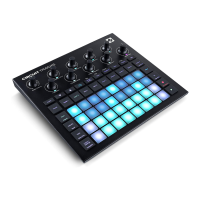54
Pattern Settings
Although default Pattern lengths are either 16 or 32 steps (see also “Step Page and 16/32-step
Patterns” at page 76), it is possible for the Pattern in any track to be any other number of steps in
length, up to the maximum of 32 steps. Furthermore, the start and end points of a Pattern may be
independently defined, so that sub-sections of a Pattern, of any length, may be played against other
tracks with different Pattern lengths, creating some very interesting effects. You can also choose
Pattern play order and set the speed of the track relative to that of other tracks.
All these options are set in the Pattern Settings View; press Pattern Settings to open this:
End
point
Start
point
1 2 3 4 5 6 7 8
These four steps have
notes/hits associated with
them
Pattern step display
Sync rate display
Play order selection
Press Shift to
toggle Pattern Start
point with Pattern
End point
Pattern is stopped at
the blue/white pulsing
step (Synth & MIDI
tracks only)
Any alterations to the track Pattern made in Pattern Settings View can be saved to the Project in the
usual way.
Start and End points
The upper two rows of the Pattern Settings View show the Pattern steps for the currently selected
track. If no adjustments have yet been made to Pattern length, Pad 16 will be illuminated sand: this
indicates the last step in the Pattern. However if the Pattern length is 32 steps, you will need to press
the Step Page button 8 to open Page 2 in order to see the end step indication. To see which step
is currently the Pattern start point, press and hold Shift. The end point step returns to blue and a
different step pad lights sand: this will be Pad 1 if Pattern length has not yet been altered.
You can change the end point for the track– and hence shorten the Pattern length - by pressing a
different Pattern step pad. The new end point is indicated by a sand illumination, and the “higher”
pads either go dark or dim red, the latter indicating that note/hit data has previously been assigned
to that step. If you reselect the original end point, this data will still be there and will be played.

